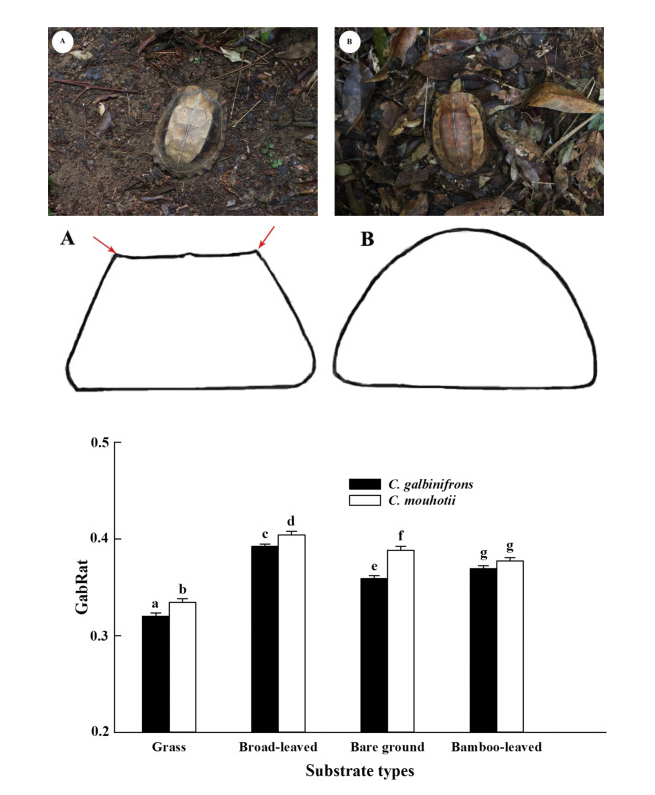
Chelonians have evolved on Earth for more than 200 million years and have unique morphological characteristics and distinctive behavioural response mechanisms that go with them. Therefore they have special conservation needs and methods with important research and conservation value.
1. Discovered a new camouflage strategy for Animalia and that chelonians have camouflage behaviour.
It is the first time in China to study the camouflage behaviour of chelonians, including background matching, camouflage and mixed cryptic colors.
The disruptive colouration of Cuora mouhotii was investigated by using the Gabor disruptive ratio method, and it was found that the top of the carapace of C. mouhotii was cut flat to form a new shape edge, which caused visual misjudgment to the predator, and thus gained the disruptive colouration function. In addition, this disruptive colouration was a disruptive colouration caused by the structure rather than by the body colour. This is a new camouflage strategy called structural disruption, which extends the theory of cryptic colouration. This kind of structural disruption is more effective than that of C. galbinifrons, which is caused by body colour.

Fig. 1 Differences in morphology and blending ratio between C. mouhotii and C. galbinifrons.
A: C. mouhotii (left) vs. C. galbinifrons (right); B: carapace outlines of C. mouhotii (left) vs. carapace outlines of C. galbinifrons (right); C: Regardless of substrate background, the GabRat of C. mouhotii is greater than that of C. galbinifrons (Bu, Xiao... ,Shi, 2020).
We found that S. quadriocellata exhibits camouflage behaviour, preferring rocky habitats with a high degree of shape similarity to itself in order to reduce the recognition rate of natural enemies. This is the first report of camouflage behaviour in a vertebrate, which enriches the theory of anti-predation strategies in behavioural ecology and provides practical guidance for the conservation of the authenticity of species' habitats.

Fig. 2 Shape similarity between S. quadriocellata and rocks in streams (A) and its upstream and downstream habitats (B,C,D) (Xiao et al.,2021).
2.Discovered the ecological niche differentiation mechanism of Cuora, providing scientific basis for its population recovery
We discovered the ecological niche differentiation mechanism between the critically endangered C. galbinifrons and the endangered C. mouhotii. These two species are sympatrically distributed in primary tropical rainforests with higher elevations and lower temperatures. However, C. galbinifrons prefers mixed tree-bamboo microhabitats with greater deciduous cover and thickness and gentle slopes. It prefers to hide under the loose deciduous layer and prefers plant food such as bamboo shoots; Whereas C. mouhotii prefers rocky and sloping microhabitats under arborvitae. It prefers to hide in rock crevices and primarily takes animal food such as snails. The differentiation of microhabitats and diets of the two species is mainly related to the obvious differences in their carapace and head morphology. The lack of research in this area has led to a lack of targeted protection and management, which has resulted in a large number of artificial rescue and breeding failures.

Fig. 3 Different cryptic sites (A, B) of C. mouhotii and C. galbinifrons and their shared macrohabitat (C) (Xiao et al., 2017a)

Fig. 4 Feeding behaviour of C. mouhotii and C. galbinifrons (Xiao et al., 2017b)
3. Discovered the communication behaviour of the chelonians
We discovered that chelonians hearing is sexually dimorphic and developmentally plastic, and found that Trachemys scripta elegans can emit up to 12 types of stridulations. Acoustic communication plays an important role in the life history of individual animals, including survival and reproduction. Chelonians have long been considered a "silent group", and until now most people still regard them as long-lived "dumb" or even "deaf". This discovery promotes the study of stridulations, functions and evolution of acoustic signals of chelonians, which is of great significance to understand the physiological and behavioural diversity and adaptive evolution of this ancient animal group.
4. Established a spectrum of courtship behaviour in chelonians
We have studied the courtship behaviour of Sacalia quadriocellata, Platysternon megacephalum, Cuora galbinifrons and Cuora mouhotii, and established their courtship behavioural spectrum for the first time, which enriches the study of reproductive ecology of chelonians and provides reference data for the conservation of these species.
5. Discovered that freshwater chelonians have homing behaviour.
Adults of Platysternon megacephalum were found to be highly loyal to their microhabitats and possessed homing behaviour. The recapture rate of adults at the original capture site after release at this capture site was 71.43%, and the rate of five adults returning to the original capture site after migration was 83.33%. P. megacephalum can return to their original capture site (home) from 150 to 2400 metres away, and can return to their home from upstream or downstream of the capture site, or even from other streams.

 中文
中文 English
English





